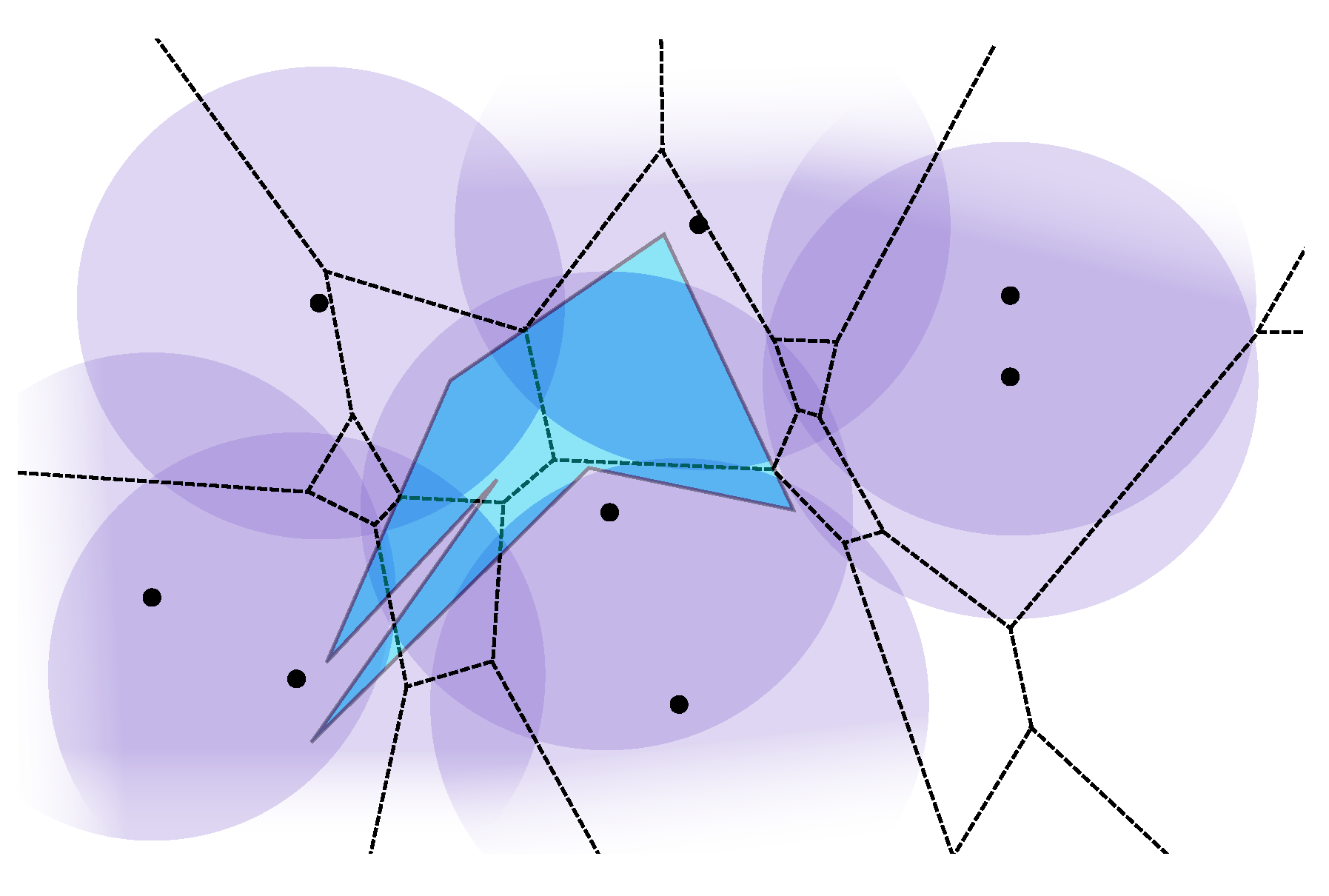计算几何 W41 Polygon Triangulation
DCEL
Definition
a planar subdivision in a complex structure 平面剖分
components:
- vertices
- faces
- edges
store two copies of each edge (opposite directions)
- one copy of edge for each adjacent face
- the adjacent face is always to the right
- edges are clockwise around each face 很巧妙,所有面都有一个顺时针的环构成
an edge points to twin, adjacent face, start and end points e.twin,e.face,e.start,e.end twin 指的是相同端点,方向相反的边
edge around a face are in a linked-list
each vertex points to an out-going adjacent edge
each face points to an adjacent edge
Line Segment Intersection
input: a set of n line segments
output: list of all intersections between the line segments. output has size k
idea: a sweep line algorithm i.e. insert the segments one by one from top to bottom.
the sweep line stops at event points
3 types of event points
- top of a segment
- bottom of a segment
- intersection point
2 data structure are required
list of event points - priority queue
allows insertion and deletion of events
status of sweep line
store the ordered list of segments intersecting the sweep line
The Algorithm
扫线算法
SweepLine(P): P is a set of n line segments
Init
l.y=inf//sweep line coordinateQ=null//priority queuesort P and add end points to Q as Top or Bottom events
init.
lto null //status of the linewhile Q is not empty
E=Q.getNextEvent()if
Eis top event ofs,l.insert(s)add int. points of
l.prev(s)ands, andl.next(s)andstoQ.if
Eis bottom event ofsadd int. points of
l.prev(s)andl.next(s)toQthen removesfroml.if
Eis int event ofs1,s2l.swap(s1,s2)then add int. points ofl.prev(s2),s2, andl.next(s1),s1toQ
Sweep Line Status
a data structure
- maintain order
- find
- insert
- delete
- swap order
solution: an abstract balanced binary search tree
SweepLine(P ): P is a set of n line segments
Initialization:
• .y ← +∞ // sweep line coordinate
• Q ← ∅ // priority queue
• Sort P and add end points to Q as Top or Bottom events
• Init. to ∅ // status of the line.While Q is not empty
2.1 E ← Q.getNextEvent()
2.2 If E is top event of s, .insert(s)
Add int. points of .prev(s) and s, and l.next(s) and s to Q
2.3 If E is bottom event of s
Add int. points of l.prev(s) and l.next(s) to Q then remove s from l
2.4 If E is int event of s1, s2, l.swap(s1, s2) then add int. points of l.prev(s2), s2, and l.next(s1), s1 to Q
扫线算法的中文解释:
两个数据结构:一条链表,负责记录所有线段的端点和已经找到的焦点,每个点按 y 递减顺序排列。一颗二叉树,负责记录与扫描线段相交的线段(的端点),每条线段按照上端点的 x 坐标递增。
开始扫描!
扫描到一个新点是某线段的上端点:将改点存入二叉树中,在树中找到该端点对应线段的左邻居线段和右邻居线段,检查该线段是否与左右邻居分别相交,如果相交就把端点存入链表。
扫描到一个新点是某线段的下端点:在二叉树中找到该线段的上端点,找到上端点的左右邻居,检查左右另据是否相交。如果有交点,存入链表。
扫描到一个交点:输出这个交点的坐标,找到左线段的左邻居,检查左线段是否和左邻居相交;找到右线段的右邻居,检查右线段是否与右邻居相交。如果有交点就存入链表。
时间复杂度 n 是线段树,k 是交点数。
Polygon Traingulation
多边形的三角剖分
a polygon with vertices
trangulation: decomposition of into triangels
it is fundamental proprocessing step.
一个多边形的三角剖分可能有多解
a simple polygon must satisfy:
- no self-intersections
- no holes
output: a decomposition into trangles using DCEL, or just a list of triangles
claim
It’s always possible.
通过归纳法 induction 证明,如果连线了,那么分成的两个部分的其他点的个数是 1 到 n-2
given a single polygon P with >3 vertices, there exist two non-adjacent vertices, v, w, s.t. vw is inside P and does not intersect the boundary of P.
let u be the leftmost point, both neighbors of are to the right of u.
case 1 vw does not intersect boundary of P.
case 2 vw intersects boundary of P.
there exist at least vertices of P inside uvw.
solution: let x be the vertex be the farthest away from vw. no vertex inside trinangle uv’w’ (v’w’ 平行于 vw 并且过 x 点), line px doesnot intersect P and cuts it into to polygons of smallersize.
number of triangles is .
Algorithm for Monotone Polygon Triangulation
trivial algorithm:
a Y-monotone polygon: every horizontal line intersects at most two edges of P
claim: a Y-monotone polygon can be triangulated in time.
We can triangulate by recursively adding diagonals:
- Take the highest leftmost vertex v .
- Try first to connect the neighbors u and w.
- If u and w cannot be connected, connect v to the vertex farthest from the edge (u, w) inside the triangle spanned by u, v , and w.



